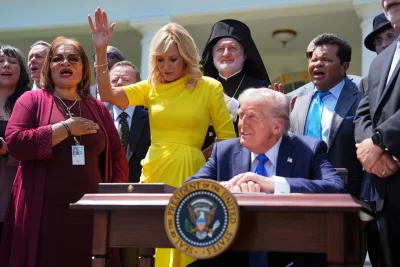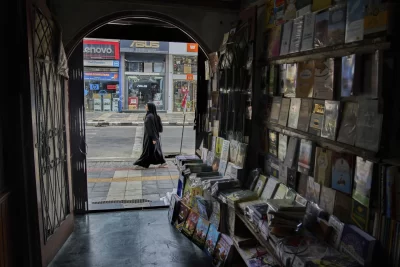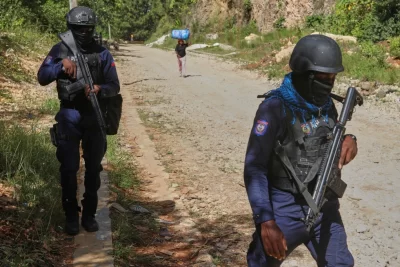In a country shadowed by the threat of mass shootings and neighborhood violence, courts have embraced an increasingly absolute reading of the right to guns. That raises difficult questions about how to protect the full range of freedoms Americans cherish.
With nearly 400 million guns in civilian hands, the violence they enable feels to many like a threat to their right to worship in peace, go to school and be safe at home. To many others, an unfettered right to own and carry guns is essential to protecting those liberties.
With shooting deaths in the U.S. up sharply, The Associated Press examined the rising tensions between those beliefs and the struggle for answers. Here are the key takeaways from each story:
Amendment vs. commandment: Do guns belong in churches?
When two pastors rise to their respective pulpits on a Sunday morning, both shoulder a growing weariness about shootings in the world outside their doors. But their views on how to respond are diametrically opposite.
“I’m really not free if I have to sit here and worry about threats to a congregation,” says the Rev. Jimmie Hardaway Jr., who carries a concealed pistol to protect worshippers at his church and has sued New York officials for the right to continue doing so.
But the Rev. Stephen Cady believes that bringing guns into his church, about 90 miles from Hardaway’s, would violate its sense of community and reflection.
“Can you serve God and guns? I don’t think you can,” he says. “I think you have to make a choice.”
Their disagreement spotlights the increasing friction between the assertion of two American principles: the right to worship and the right to own guns. After a series of attacks on U.S. houses of worship, the sense of threat is visceral for many congregations, forcing faith leaders to weight often pained choices between maintaining openness and locking down.
In one recent survey of protestant pastors, 62 percent said that their duties now include making plans for responding to an active shooter in their chapels and grounds.
How can America protect its protectors?
In towns across east Texas, Barbie Rohde tells her story to anyone who will listen.
She worried about the mental well-being of her son, an Army sergeant whose hand had been blown off in a training accident. But when he asked for his guns back, what choice did she have?
Then came the knock on her door, to tell her he’d used one of those guns to kill himself.
“I just sat on the floor and screamed,” she recalls.
The circumstances of her son’s death were hardly unique. Each year thousands of U.S. soldiers and veterans, many haunted by trauma sustained in the line of duty, take their own lives, the vast majority using a gun. In 2020, for example, suicide was the second leading cause of death among veterans younger than 45.
Families and experts say it’s likely many of those men and women would still be alive if not for ready access to firearms, raising difficult questions about what the nation owes those who serve and pay the price.
That can be a hard message to deliver in communities where people believe deeply in the Second Amendment and the value of guns in providing protection. Rohde believes in that, too. But sometimes, she says, the gun you thought would protect you might be what destroys you instead.
In abusive relationships, should one partner’s right to guns supersede the other’s right to safety?
When a judge finally ordered the seizure of dozens of guns belonging to Janet Paulsen’s husband, deputies decided that didn’t cover the one in his truck. Five days later, he used that weapon to shoot her.
“It took me five years to get up the courage to divorce him, because I knew I would pay the price,” says Paulsen, of Acworth, Ga., who was left paralyzed from the waist down.
Every year, hundreds of cases like hers confront judges and police with equally fraught choices, pitting a victim’s right to safety against an abuser’s right to guns. Different jurisdictions have different laws, and enforcement is uneven. Now the Supreme Court is preparing to step in, weighing whether people deemed to be a threat can be forced to relinquish their firearms if they have not yet been convicted of a crime.
Fewer than half of the U.S. states have laws allowing courts to order removal of someone’s guns when it is determined that they pose a danger to themselves or others. In many that do, enforcement can be uneven, leaving survivors of domestic abuse vulnerable. To improve the odds, some communities have adopted a model that calls for a comprehensive review and quick action.
But a Texas court has ruled such programs are unconstitutional. If the Supreme Court says they can’t, advocates fear that could endanger the lives of hundreds of abuse victims each year.
In the wake of school shootings and neighborhood violence, how can parents and children feel safe?
More than 25 years after Hollan Holm survived a school shooting in a small Kentucky town, he struggles to reassure his own children.
“I can’t really go into crowds of people and not be concerned about maybe somebody’s going to do something with a gun … and I don’t want them to have to live like that,” Holm says. “I just want them to be kids.”
For Krista Gwynn, whose son was killed in a drive-by shooting in the state’s largest city in 2019, the trauma is much fresher.
“Who wants to live with the fact that when I take my child to the park I have to watch every person who drives through?” says Gwynn, who decided to home school her youngest daughter to keep her safe.
In a country that has weathered a record number of mass killings this year and a surge in youth deaths by firearms, many parents worry for their children. About 2/3 of those who responded to a recent poll by the Pew Research Center said they are very or somewhat worried about a shooting happening at their child’s school, one recent poll found.
But the apprehension can be even harder to handle for parents who have already endured shootings.
Is the right to the “pursuit of happiness” compatible with the proliferation of guns and shootings?
Life as Sandy Phillips knew it came to an end with a middle-of-the-night call.
“Jessi’s dead,” she screamed as she fell to the floor. “Jessi’s dead!”
In the months after her daughter was killed in a mass shooting at a Colorado movie theater, the darkness was all consuming. But maybe, she and her husband told themselves, they could find new purpose in their grief.
And so they set out on a journey, to Newtown and Buffalo, Highland Park and Uvalde, and countless places in between. They did so to reassure others just like them. Just as much, though, they went in pursuit of happiness — the unalienable right so prized by the nation’s founders — until it was snatched away.
But as the drumbeat of mass shootings continued with little hope of resolution, the couple confronted a painful reality.
“We had our daughter taken. We lost everything we had,” Phillips says. “And we lost our country.”
About Author








